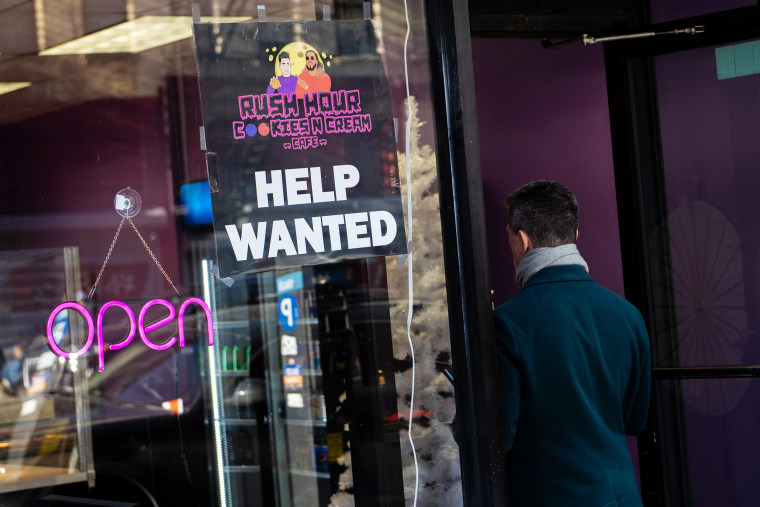America’s jobs market ended 2021 in a markedly different climate from the one in which the year began: The numbers of open jobs and people walking off the job appeared to stabilize in December — albeit at stratospheric levels — according to the new Job Openings and Labor Turnover Survey released Tuesday.
The number of people who quit their jobs in December fell slightly from the previous month’s record of 4.5 million, to 4.3 million. Economists say the data reflect the profound distortions remaining in the labor market nearly two years after the Covid-19 pandemic started spreading across the U.S.
11 million open jobs points to a growing recognition among employers of the need to move forward — pandemic or no pandemic.
There were 10.9 million job openings in December — a figure nearly triple that of a year ago and marginally higher than the 10.6 million job openings at the end of November.
The Bureau of Labor Statistics noted that job openings jumped by 133,000 at accommodation and food service employers.
“In general, it wasn’t a big surprise. We knew employers had a lot of need,” said Ron Hetrick, a senior economist at Emsi Burning Glass. “We’re still seeing most of our demand occurring in that lower-skilled worker population.”
The report also showed smaller increases in information services, nondurable goods manufacturing and education (state and local), which collectively totaled just over 100,000.
“Despite the omicron variant, demand for workers is still near record highs,” said Daniel Zhao, a senior economist at Glassdoor. “This is a sign employers are hoping that the omicron wave will be temporary.”
Rhea Moss, the director of data insights and customer intelligence at iCIMS, a recruiting software company, said nearly 11 million open jobs pointed to a growing recognition among employers of the need to move forward — pandemic or no pandemic.
“What we’re seeing now is there’s a comfort level,” she said. “You add this labor market situation with resignation rates where they are [and] companies can’t necessarily afford to stop hiring. It may be the start of better days in the hiring market.”
But first, labor market observers are bracing for more bad news in the near term. Even the most optimistic expect that the monthly jobs report set to be released Friday will reflect only modest growth in January, and some have even suggested that the reading could turn negative.
“I think we’re heading for another disappointing number,” Hetrick said. “Omicron was kind of on the upswing during their survey week in December. ... We’re not out of the woods.”
Many said the continued high number of people who are quitting their jobs suggests that wage growth — an imperfect, albeit common, proxy for inflationary pressure — will remain robust. Wages grew on a year-over-year basis by an average of 4.7 percent in December.
“It’s the seventh straight month of jobs openings above 10 million,” said Greg Bassuk, the CEO of AXS Investments. “The consistency of these high levels is going to be a factor in seeing more extended levels of wage growth. This is one of those reports the Federal Reserve has really been keeping a close eye on.”
Employers are more willing to give workers a second chance rather than letting them go.
Zhao said, “Quits in general are a strong indication that wages are on the rise, because many of these workers who are quitting are leaving for better opportunities.” But he pushed back against the idea that runaway inflation is a foregone conclusion.
“Certainly, the longer that we see sustained inflation the more pressure that puts on employers to raise wages to actually keep up with that inflation,” he said. “At this point, we aren’t seeing strong evidence of a wage price spiral.”
Others argued that higher productivity, combined with investment aimed at sustaining and generating further gains in worker output, could help mitigate the economic impact of higher wages and salaries.
“Not all wage costs need to go to price increases,” said Luke Tilley, the chief economist at Wilmington Trust. “We do have strong productivity growth right now, so that’s one thing that would lessen the impact of this wage growth going into prices.”
In addition, the flip side of employees’ being increasingly willing to quit is that employers are pulling out all the stops to retain the workers they have — and companies are willing to spend money on workers and workplaces to do it.
“We’re very focused on the dramatic amount of investment in technology capex,” or capital expenditures, Tilley said.
Layoffs dropped to 1.2 million in December, the lowest since the Bureau of Labor Statistics began tracking. “The record low layoff rate suggests that employers are holding on to the workers they do have. Employers are extremely focused on retention,” Zhao said.
On balance, it could be a positive for businesses as well as workers in the longer term if the labor market emerges into a post-pandemic world with workers who are better adapted to the current workforce demands, thanks to investments in productivity-boosting equipment and training.
“Employers are investing more in upskilling and job training because they need to keep up with the shortage of workers,” Zhao said. “We have heard of employers doing more to offer on-the-job training or skill development. Employers are more willing to give workers a second chance rather than letting them go.”
